The Japanese decision not to sign the 1936 London Naval Treaty placed the British in a bind. The treaty had been the latest step in a 15-year effort to hold down the size and cost of battleships, which had been working reasonably well. The British had considered the 35,000 ton, 14" gun treaty battleship limits too loose, and now Japanese intransigence would force another step up in gun caliber and tonnage relative to the ships of the King George V class, which were about to be laid down.
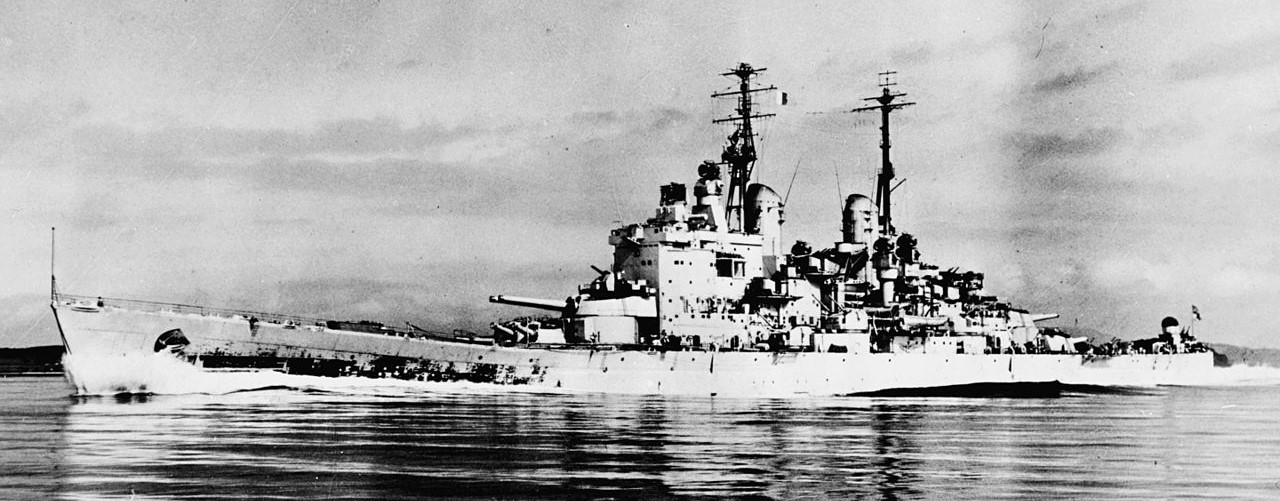
Vanguard on trials1
As usual, design studies had begun even before the first escalator clause, raising the treaty cap from 14" to 16", was invoked when Japan failed to sign. In some ways, the British were well-positioned for the change, as the King George V had, rather unusually, been designed for protection against 16" gunfire while carrying 14" guns. However, the greater weight of 15" or 16" guns would have meant unacceptable cuts in speed, so it was fortunate that negotiations quickly began for invoking the second escalator clause, which would allow increases in the tonnage limit over the 35,000 tons allowed by the treaty.
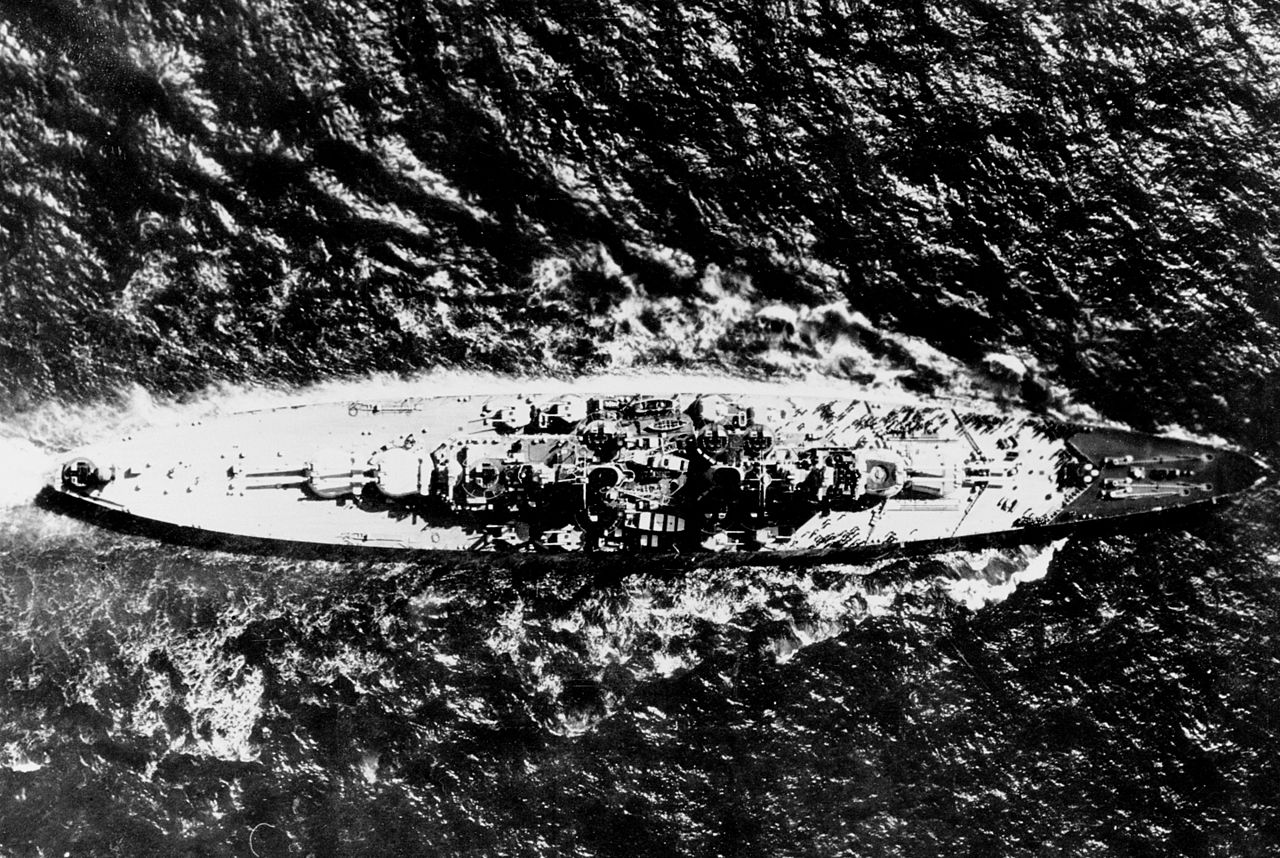
To get ships ready for the 1938 program, sketch designs would be needed in late 1937, before the escalator clause was actually invoked. Some effort was made to find a ship with 16" guns that stayed under the treaty limit. This would mean sacrificing either firepower (two triple turrets were all that could be accommodated), speed and aviation facilities, or a significant amount of armor, with one scheme showing a 7" belt and 2.25" deck over the machinery2 with the same protection as the King George V for the magazine. None of these were satisfactory, and the escalator clause was clearly going to be invoked, so they eventually settled on a fairly simple upgrade of the KGV with three triple 16" turrets, on 40,500 tons.3 The big question was the amount of escalation allowed, and while the British pushed for a 40,000 ton limit, the Americans had already authorized 45,000 ton ships and offered the British a choice between a 45,000 ton limit and no limit at all. They reluctantly took the 45,000 ton limit, but stuck with their 40,000 ton ship, as a bigger vessel would have been unable to dock at the Royal Dockyards.
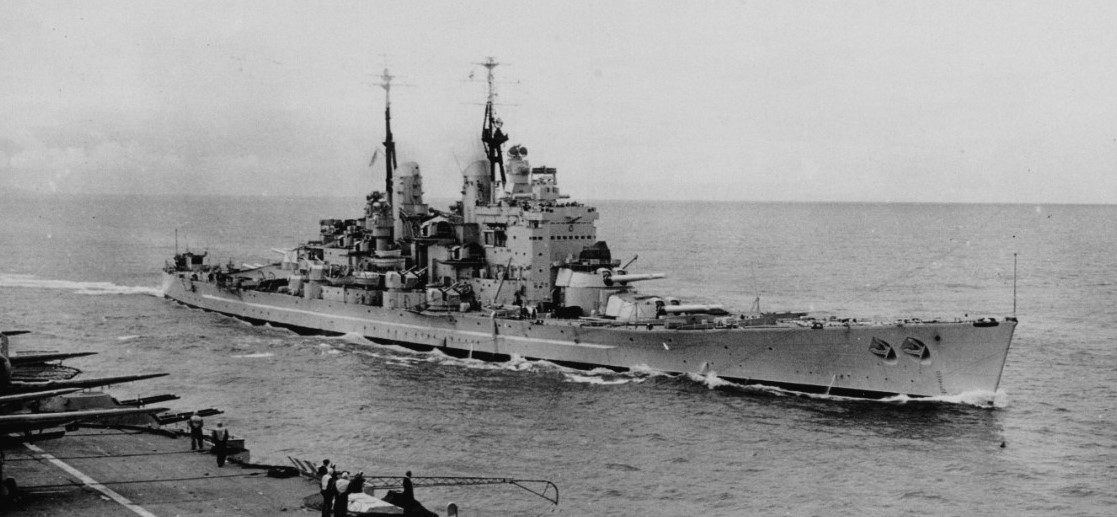
Vanguard alongside a British carrier
The first pair of ships built to this design, Lion and Temeraire, were ordered in February 1939, and laid down a few months later. Another pair, Conqueror and Thunderer, were ordered in August. Unfortunately, war broke out the following month, and the second pair were never laid down. Work continued on long-lead items, mostly guns and mounts, and construction on the first two continued on and off until May 1940. At that point, they were suspended for the duration of the war.4

By late 1941, the British had a great deal of war experience to draw on, which obviously lead to a desire to revise the Lion design. Flaws included limited endurance, insufficient light AA armament, lack of freeboard forward,5 too much reliance on steam for power generation and ends that were vulnerable to bomb and shell splinters. Fixing all of these problems would cost about 2,000 tons and half a knot of speed and increase beam from the 105' limit of most British drydocks to the 108' limit of the Panama Canal, even though the aircraft facilities were removed. An attempt at increasing deck protection had to be abandoned because it would have cost a turret. Unfortunately, the need for other ships, particularly light carriers, meant that this design was never laid down.
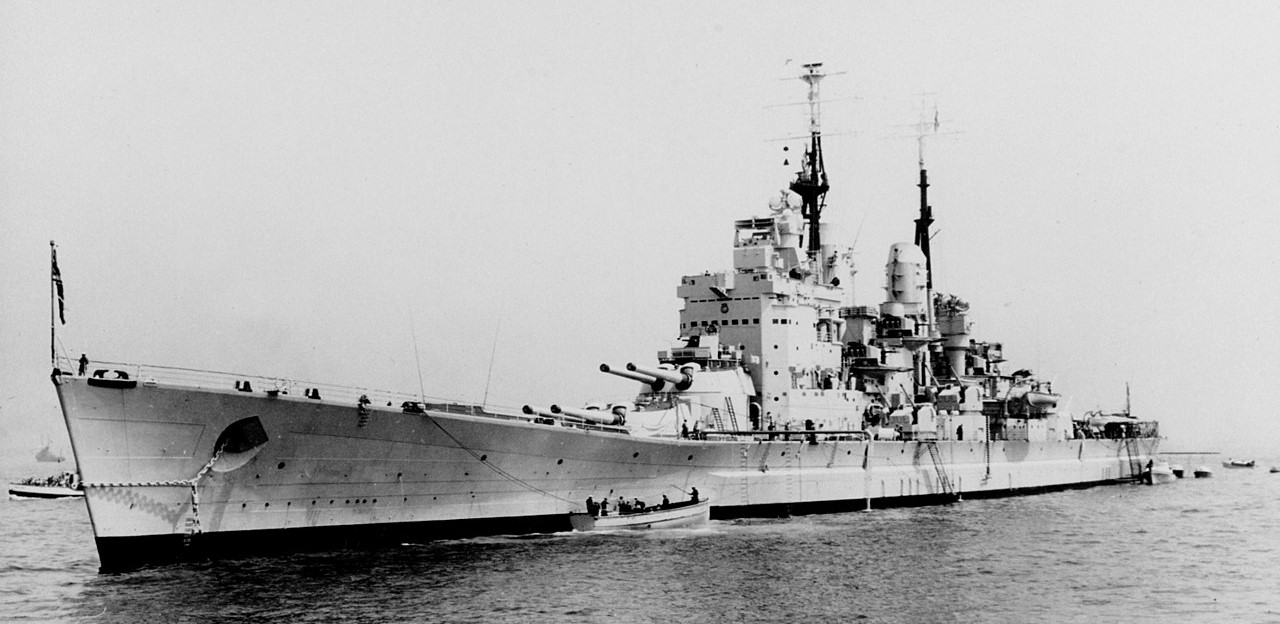
By early 1939, it had become obvious that if the British were to maintain their margin of superiority in the case of a two-front war against both Germany and Japan, they would need even more modern battleships. Unfortunately, even Lion and Temeraire wouldn't be completed until 1943 at the earliest, and simply ordering more ships wouldn't solve the problem. The British had only a few pits in which the 16" turrets could be assembled, enough for about 2 ships a year.6 The only way around this bottleneck was to use existing turrets, and the British just happened to have a quartet of WWI-era 15" mounts, originally installed on the battlecruisers Courageous and Glorious and removed when those ships were converted to aircraft carriers. A Lion derivative armed with these weapons could provide a sorely-needed extra ship, and later units could be fitted with turrets made available as the Revenge class were retired. The first unit could be ordered in August 1940, and launched two years later, with delivery to the fleet in early 1944.
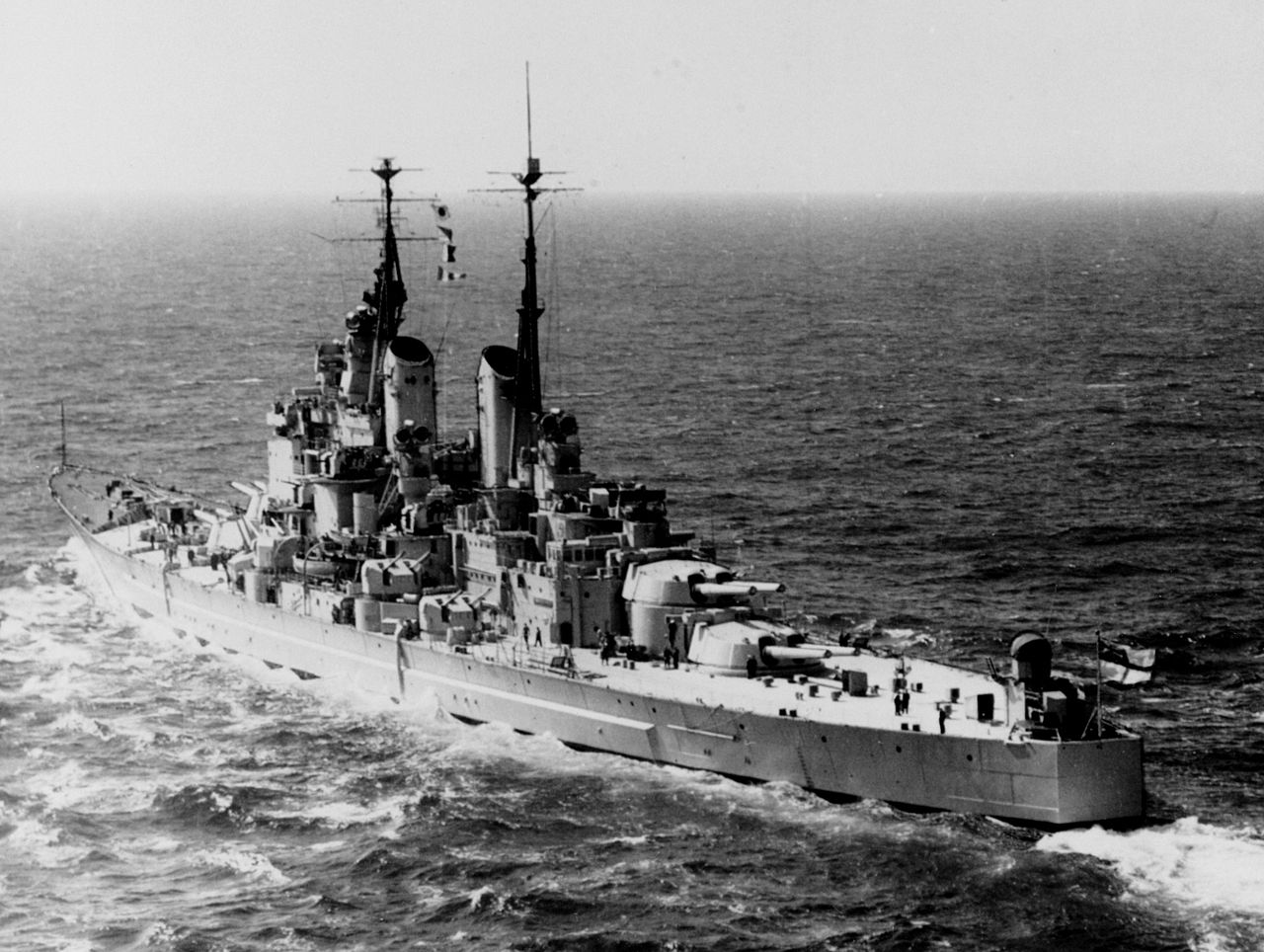
Sketch designs of this ship, which would ultimately be named Vanguard,7 were prepared, but no decision was made before war broke out and the work was placed on the back burner for a few months, until design work resumed in early 1940. The changes made mirrored those made to Lion a year later, with extra fuel and a 2.5" splinter belt on the soft ends of the ship. In March, the ship was officially included in the 1940 program, although construction didn't start yet. In September, the design's beam was increased to 108' to hold down draft, and the side armor was cut from 15"/14" to 14"/13" to compensate for the extra deck armor required, although improvements in armor quality meant that the protection was essentially what had been planned.
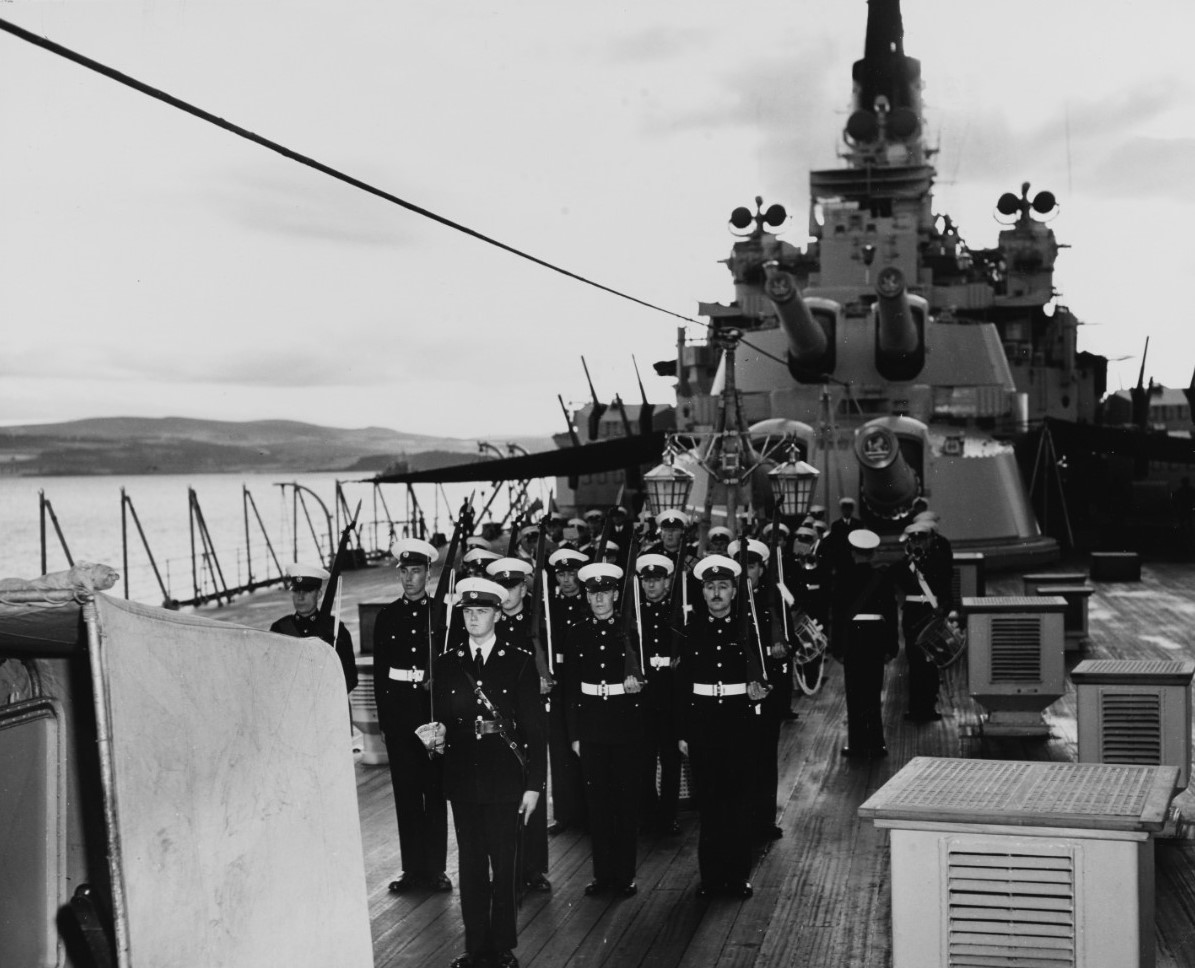
Vanguard's Marines on parade in 1952. Note the double balls in the background, which are British Type 275 radars fitted to the Mk 37 directors.
A bigger change was in the fire control for the secondary battery. The British High-Angle Control System was based on making assumptions about the target instead of direct measurements like tachymetric systems such as the American Mk 37.8 In 1941, the Americans agreed to refit the cruiser Delhi with the Mk 37 and 5"/38 gun, and to transfer Mk 37s for use aboard Vanguard, although they had to be modified to handle the ballistics of British guns. The increasing need for light AA guns required sacrificing the aircraft facilities. That November, orders came to transfer steel that had been procured for Lion to Vanguard, and the ship was given IA priority by Churchill, with completion planned for September 1944. More tweaks were made in 1942 based on the loss of Prince of Wales, improving watertightness and adding even more AA firepower. These modifications and shifting priorities in general delayed the ship, and she wasn't launched until December 1944, the last battleship ever to be sent down the ways. Completion was planned for a year later, but the end of the war delayed it into 1946.
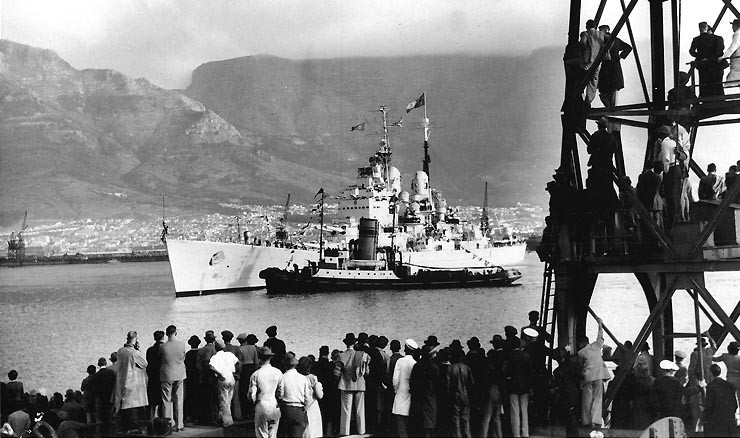
Vanguard at Cape Town during the 1947 Royal Tour, with George VI onboard
Postwar, there was some consideration of completing Lion and some of her sisters to a radically altered design to take full advantage of the lessons of war. The postwar financial crisis killed off these plans, and Vanguard formed the last link in the long and illustrious chain of battleships stretching all the way from Warrior. The 85 years separating the ships had seen immense changes in technology and strategy, but for most of that time, the battleship had been the ultimate instrument of seapower, one of the great forces shaping the destiny of the world.
1 Unfortunately, I don't have any public diagrams of the Lion class for fairly obvious reasons. They look pretty much like King George Vs that have three triple turrets. Fortunately, Vanguard was an extraordinarily pretty ship, so I don't feel bad about illustrating this post with photos of her. ⇑
2 These are half the values for the earlier ship. ⇑
3 One interesting feature of this design is that the aft director was mounted on the aft turret. I'm not entirely sure why. ⇑
4 A particularly amusing anecdote of this design involves Winston Churchill, who became First Lord of the Admiralty again when war broke out. He though that the gap in the superstructure for the catapults meant there was a gap in the ship's protection, too. After he was convinced this was not the case and that the citadel ran under it, he began agitating to remove the aviation facilities to shrink the citadel. It was then pointed out that this wouldn't work because the size of the citadel was set by all the stuff that had to go into it. I'm not sure how this can be reconciled with the claims that the KGVs aviation facilities cost them the equivalent of a turret. ⇑
5 This was caused by a requirement to be able to fire the forward turrets directly ahead at 0 elevation, and when it was removed, the bow could be given sheer to improve seakeeping. ⇑
6 The Washington Naval Treaty had done great damage to British capability in this area, probably because the majority of their capability in the field was in the hands of the great armaments firms, who couldn't afford to maintain it during the battleship holiday. The US doesn't appear to have had nearly the same trouble, probably because the work was done in government facilities, which could be kept alive even when there was no work. I suspect there may have been some major differences in practice which meant that turrets were generally less of a bottlneck for the US, but sources on the matter are nonexistent. ⇑
7 Due to her armament, Vanguard was nicknamed "the battleship with her great-aunt's teeth". ⇑
8 This is a very complicated issue, and I'll cover it properly at some point. ⇑

Comments
Re completing battleships post war, would this have been worthwhile even if it was affordable? Who else had battleships for them to fight? The biggest surface combatants I could see a argument for building would be small battlecruisers/big heavy cruisers to accompany the carriers and hunt down enemy cruisers. Even that would soon be heavier than you'd prefer as technology tilts in favour of missiles, aircraft and submarines.
Your footnote 6 explains why the turrets were such a huge limit, in a way I'd previously found a bit surprising(and which, IIRC, you did as well a couple years ago). Interesting. Is there enough info on that to warrant a whole post? Yes, I'm enough of a dork to want a full post on that.
Alexander: I suspect they expected somebody to re-arm(perhaps the USSR), or for sheer inertia's sake. It's not always obvious which items have become obsolete until after the fact, and naval architecture is not an especially aggressive field.
@Alexander
That's something I plan to come back to. There was serious and well-founded concern that the Soviets might continue battleship construction, and until the late 50s, carriers were still seriously vulnerable to surface attack at night or in bad weather. But they probably had all the ships they needed.
@Alsadius
You and me both. It seems like the difference in British and American practice on this is a really obvious question, and yet it's one that nobody has answered. Footnote 6 is my best guess, but there's a lot of reading between the lines in it. On the technical side, you have a few great books on American battleships, and a bunch of Osprey-style pulps, but nothing in between. It's incredibly frustrating, particularly as all of the great books are older than I am. I wonder if it's hard to get out of their shadow, or just that much easier to go sorting through the British archives.
I wonder if there were British analysts who could see that their "success" at the Naval treaties was in fact breaking the basis for British naval power. There are probably, deep in various archives, lots of personal letters and memos that are seething with (highly restrained and formally stated) enraged despair at the basis for British power being traded away for temporary budget relief.
Bonus question: can we point to similar situations in operation today?
The basis for British naval power had always been geography and financial supremacy. The first was obviously unaffected by the treaties, and the second had been destroyed by the war. The British couldn't have afforded to keep a big fleet in commission, period. The Washington Naval Treaty benefited everyone, including both the British and the Americans, despite claims of later partisans. (The introduction to Volume 1 of Morison is a good example from the USN side.)
Britain absolutely had the financial and industrial resources for a huge fleet had there been the political will and public support for it. The ludicrously exorbitant other major expenditures of the wartime and immediate postwar era show that the UK had the resources and industrial capacity available, but wasn't willing to make those sacrifices in peacetime during the 30s . The strategic bombing campaign was particularly fiscally backbreaking, not to mention the costs of sustaining the British Army of the Rhine, the nuclear program, and the burgeoning NHS.
https://ses.library.usyd.edu.au/bitstream/2123/664/2/adt-NU20050104.11440202whole.pdf
This paper calculates a 2.8 billion pound total cost for Bomber Command during the war, which is a truly staggering figure compared to say a Nelson or KGV battlewagon at only 7.5 million per unit. The economic conditions that led to cancelling the G3/N3 vessels and the Washington Naval treaty only lasted for 2 years between 1921 and 1922, and by 1923 the British economy was roaring again and well able to bear the costs of further construction. Indeed, the largest economic issues facing the UK in the interwar era were high structural unemployment and unused industrial capacity, which were issues that could have been alleviated by greater defense spending.... if you're a Keynesian.
Chris, the war that destroyed Britain's fiscal supremacy was WWI, not WWII. Britain's GDP was essentially flat during the interwar years, while the US was still growing rapidly. Not to mention all the war debt they had to pay off. This is not a recipe for "if we buckle down, we'll be able to outbuild the US". From about the start of the 20th century, the UK had kept its position relative to the US basically by inertia. The US didn't see itself as a world-class seapower capable of challenging the UK. That changed in about 1916, and parity was really the best they could hope for after that.
As for post-WWII, there was no way they could maintain a huge fleet. They tried repeatedly, but the money and industrial capacity just wasn't there.
Re bomber command, money isn't that fungible during a total war. At the most basic level, bombers are made of aluminum at inland airfields. It's sort of hard to build boats there. Those decisions are made way further back. And I agree that it was largely wasted, and could have been better spent on ships. But it's not a matter of dollars (or pounds) in vs money out. Less qualified to comment on the NHS, but we have to remember that military budgeting for democracies takes place in the political arena. Waving our hands and saying "but what if there was the political will?" is not going to be particularly enlightening.
Hmm. I sense a post here. Could take a little while, though.
I don't doubt the premise that the UK could no longer outbuild the US, but my point was that it could still have entered WW2 with quite a few more ships than it did without pushing the economy to the brink of collapse.
The idea that the money that went into bomber command isn't directly translatable to ships is also somewhat true but only if you look at a period of a few frantic wartime years. Britain spent the 20s and 30s not building anything big except for the Nelsons. The shipyards and steel mills that could have built at least 8 capital ships (N3/G3) simultaneously lay completely idle due to a political shift towards disarmament rather than any real economic crunch. While GDP growth did slow, the UK still had access to the financial resources that could allow it to out-build say Japan or Italy without straining the domestic economy to the point of collapse.
Regarding the postwar scenario, it was essentially a choice of having a fleet or an independent nuclear deterrent delivered by strategic air power, and Attlee chose the 2nd option. If Britain had decided to shelter entirely under the US nuclear umbrella, they could have easily kept quite a few more battleships in service and finish the Maltas or perhaps CVA-01.
First, I'd completely agree that it probably would have been a good idea for the battleship holiday to be less complete than it was. Low-rate production would have kept the industry alive and the fleet modernizing.
But that doesn't mean the treaty was a bad idea. First, the British were facing a steep depression and couldn't see that it was temporary. I have books that I'm sure shed light on this, but I haven't read them yet.
Second, Anglo-American relations were nowhere near as strong as they have been since 1945. The UK might be able to beat Japan in a building race (although I'd like to nail down the ratio on that and make sure it's better than 5:3) but they'd run just as much chance of ending up in a race with the US, which would be bad.
Third, I'm not sure that a treaty-free would would have actually lead to a larger fleet in 1939. In the Depression, the treaty limits served as a useful minimum for the USN and RN, who were spared the really deep cuts that hit the other services.
Right, hindsight is always 20/20 when it comes to economic conditions, but totally limiting your options based on current economic conditions is also dangerous thinking. Most business cycle troughs up until 1929 in the UK had been fairly short, and the primary problems of insufficient demand for heavy industry during those recessions seem ideal for naval rearmament.
And yes, an arms race with the US wouldn't be that good for relations between each other, but it also would not have changed the political factors developing in Germany and Japan towards aggressive expansionism, and so both Anglosphere nations would have found themselves on the same side of the second world war anyways... with a lot more modern ships in commission. Heck, it might have even averted a Pacific war entirely if the Allied force ratio was too imbalanced against the IJN.
Speaking of the Pacific, one of the best arguments against the Washington Treaty comes from one of its supporters at the time: Isoroku Yamamoto out of all people.
He noted," The ratio works very well for Japan – it is a treaty to restrict the other parties."
Again, though, you're using 20/20 hindsight. Nobody knew that the Japanese would go crazy, or that Hitler would show up. The idea of Anglo-American tensions wasn't insane. As for the economy, all of my sources are unequivocal that the British really couldn't afford the fleet they wanted. Digging up hard numbers is going to take a little while, but I'll need those before I disbelieve them.
Yamamoto was a reasonably intelligent man, and saw the benefits of the treaty for Japan. A lot of people didn't. The same is true for the other two powers.
And if you want to do an adversarial collaboration on this, I've listed in on SSC.
I don't deny that there were some issues of mutual distrust between the UK and US, but they were still culturally similar democracies with very intertwined economies. There was no way the two would go to war, even if the naval arms race continued. Besides, the absence of an immediate critical threat doesn't mean that you should disarm. The very nature of global politics is unpredictable and new rivals can emerge far faster than anyone can expect, just as the fascists did the 30s and China has done more recently. Japan revealed their insane ambitions in 31 on the Manchurian railway, while Mussolini and Stalin also threatened the established world order. That's not a global political environment where a democracy should be discarding its greatest defenses.
On the economic front, I seem to recall that the G3 ships all had funding allocated and even some steel laid down, all without too much parliamentary or public outcry, and the N3 vessels to follow. The big driver towards disarmament appears to have been pressure from religious organizations and newly enfranchised women voters rather than truly dire fiscal straits, although I'm open to having my mind changed with better data. The Brits would never again have the ideal do-everything fleet, but a substantial improvement to what they showed up to war with in 1939 seems within the realm of possibility.
I might be interested in such an adversarial collaboration, but I'm afraid I don't really have the depths of naval sources that you might have access to. Funny enough, I'm actually more of a tank guy than a ship guy.
I think WW1 had just demonstrated that very entwined economies could perfectly well to war against each other, even at the cost of the destruction of said economies.
In the light of which, the disarmament move of the 1930s was weird given that everyone had a very recent example of the world collapsing into violence. Now if there was a disarmament move in 1900, THAT would have made sense. They had 75 years of peace between the major powers (ignoring Crimea and Franco-Prussian, which were fairly minor by the standards of what came before and afterwards) and so it would be much easier to believe that the nations of the world had finally worked peace out (world= western and central Europe plus the settled colonies).
Unfortunately, while I do have sources, they tend to be 500-page books that will take weeks to read. However, I did find something easier to understand. This pie chart shows UK spending in 1922. Interest on war debt was 31% of the pie, and the UK's debt-to-GDP ratio is something like Japan's is today. The chart for 1913 looks very different. Note that there was rapid inflation during this time, so we have to be careful about how we handle our numbers. Pre-war, central government spending was 7.2% of GDP, with the Navy getting a quarter of the pie. By 1922, central government spending is up to 23.7% of GDP. The Navy gets 7.6% of that. The 80 million they got in 1922 was less than half of what they'd asked for two years earlier.
Also, note that GDP actually fell 9% between 1921 and 1922. None of these strike me as a particularly healthy economy, able to stand the strains of a naval race with the US. And Roskill's Naval Policy Between the Wars is very clear that such a race was brewing.
This is definitely not true. The 1921-22 estimates were for 80 million (Roskill), with a 2.5 million supplementary for "the replacement of obsolete ships", without specification of what ships those would be. This appears to have funded the preliminary work on the G3s, but they didn't want to say that because of fear of inflaming the Big Navy Lobby in the US. Friedman says that each ship would have cost about 9 million. Four would be close to half the estimates, and the RN estimates fell close to 50% 1920-21 and another 10% 21-22.
For extra reference, here's a source with GDP comparisons of the powers in 1938 on page 21 (later than the time we care about, but should be a decent guide?).
US GDP was $800B in 1938, UK $284B, Japan $169B. So if we assume they were capable of spending the same fractions on ships, the UK had no hope of racing the US and could barely have done better than 5:3 with Japan.
But wait! Those numbers are "international dollars", meaning adjusted for local purchasing power. This forum post, which cites the book of the guy who wrote the paper above, gives nominal GDPs of $84.7B for the US, $27.5B for the UK, and just $7.5B for Japan. By these numbers, the UK is even more doomed when it comes to competing with the US, but can do better than 3:1 against Japan.
(If comparable warships had comparable costs between nations at contemporary official exchange rates, nominal is the way to go)